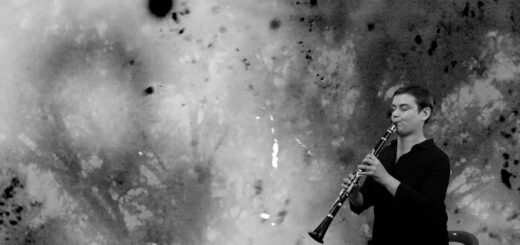June Young Will Kim: Némo for Amplified Canvas & MaxMSP Live Electronics
Beschreibung:
Némo is the second piece in a series of works exploring the possible symbiotic relationship between the visual (mainly involving paint) and musical domains of art, where the two domains are influencing each other at equal levels rather than one being a byproduct of the other. I wanted to explore in this particular work the idea of calculated imperfection, a term that came into my mind as I was studying the paintings of Agnes Martin. Agnes Martin was a Canadian American painter known mostly for her paintings featuring what appear to be simple lines forming perfect grids. But upon closer inspection, I noticed that these grids aren’t perfect but rather imperfect in a calculated way. In one of her works, “Summer” (1996), a seemingly regular grid is drawn in black in front of a blue background. And in each of the grids, there is a white dot. The straight lines of the grid and the pattern of white dots appearing in every grid square create a sense of regularity and structure. However, the dots are not placed directly in the center of each grid but deviate ever so slightly in each one. One of the grids is even missing a dot. And the blue background paint is not a solid blue, but an unpredictable mixture of darker and lighter shades of blue. These irregularities for me created meaningful and interesting visual tension against the rigid structure of the grid. One impression might be that these seemingly minor deviations are caused by human imperfection. However, after examining pages of Agnes Martin’s notebooks and footages of her at work, I realized that all these deviations from “perfectness” were calculated. In the footages, she has rulers, protractors, and a large yardstick handy, meaning she could have made the size of each grid square even and each of the dot placements be perfectly center of each grid square if she had wanted to. And scans of her notebooks for sketches behind her paintings show meticulous mathematical calculations behind the decisions she made.
As she has done so in her paintings, I came up with “calculated imperfections” that would create visual and musical tension in this piece. The thematic motif is a square, or némo, and a specific rhythmic pattern that the performer must follow in painting the square. Each of the visual deviations trigger musical effects through Max MSP processing, as if in a cause-and-effect relationship. This serves a purpose to reinforce the sense of tension created in each other’s domain.
The first type of deviation is a square where the bottom side is painted on with a violent flick at the end so that it protrudes out. A “flick effect” is applied through Max MSP, consisting of delay and filter modules. The second type of deviation is a square that’s been rotated. A total of 5 different angles of rotation (-30°, -15°, 15°, 30°, 45°) are used in this piece, with the negative angles in counter-clockwise and the positive angles in the clockwise direction. Here, a filter with 5 different parameter settings (one for each angle of rotation) is used to directly modify the dry signal. The third type of deviation is a square that is colliding with another square. If one or more sides of one square intersect one or more sides of another square, then a “collision effect” consisting of a very short but powerful realtime granulation sound is triggered. The fourth type of deviation is a square that is retraced. Anytime one or more sides of a square is retraced, an effect chain consisting of phaser, tremolo and pulse width modulation effect is used to directly modify the dry signal. The fifth type of deviation is a square that is left incomplete, or where the painting of the bottom side is delayed for a long period of time. Here, an effect chain consisting of multi-pattern tremolo, EQ and pitchshifter is used to create a sustained sound that lingers on until the bottom side of the square is finally painted. And to reflect 5 different deviations in the physical sizes of the incomplete square, there are also 6 different parameter settings (5+original size) for the tremolo pattern and filter. Two or more squares can be incomplete at the same time as well, triggering multiple incomplete square effects in polyphony. In some moments of the piece, the visual tension created by the accumulation of incomplete squares of different rotation angles and sizes are reflected in the musical domain by the accumulation of the incomplete square tremolo effects of different tremolo patterns/rates/phases. Combinations of the five deviations listed above, such as a “rotated incomplete square,” trigger combinations of the effects as well.
Némo or 네모 in Korean means “square.”
Biografie des Autors:
Composer and baritone June Young (Will) Kim (b. 1996) is particularly interested in exploring relationships between the visual and musical arts to create pieces where the two have a symbiotic relationship rather than one being a byproduct of the other. Works exploring such concepts include a piece for an amplified canvas + Max MSP and a piece for amplified canvas, motion sensor, MaxMSP + chamber ensemble. His teachers in composition include Isabel Mundry, Chaya Czernowin, Salvatore Sciarrino, Sven-David Sandström, Frédéric Durieux, Claude Baker, Christopher Rouse, David Dzubay, Don Freund, Andrew Mead, Aaron Travers, and Phuc Phan. His teachers in electronic music include John Gibson and Jeffrey Hass.
He was recently awarded the München Landeshaupstadt Musikstipendium of 6000 euros to compose a piece for amplified canvas, motion sensor, MaxMSP + chamber ensemble.
He is also one of the four selected composers to participate at the Berlin Philharmonic OpusONE in June where his piece will be performed by members of the Berlin Philharmonic at their chamber hall.
Other honors include awards from eviMus festival, ASCAP Morton Gould Awards, Texas Symphony Orchestra, Eduard Balsys International Competition, Andrew Park Foundation, International Chopin & Friends Festival, Composer’s Recording Project and Six Memos Ensemble. He recently attended the Domaine Forget New Music Festival 2019 where he studied with Chaya Czernowin, and the Accademia Chigiana 2019 where he studied with Salvatore Sciarrino. He graduated from the Jacobs School of Music, Indiana University Bloomington in 2018. He is currently pursuing a Masters in Composition at Hochschule Für Musik und Theater München with Isabel Mundry and is funded by DAAD scholarship.
As a lyric Baritone, he studied voice performance (double major) under Professor Peter Volpe at Indiana University and is currently studying under Professor Bernhard Spingler at Hochschule Für Musik und Theater München. He has been an active performer premiering works by student composers. He is currently a member of the Madrigal Chor München.
Interpreten und Ort:
First Performance: New York, July 1 2020 Second Performance: @eviMus festival 2020 (selected composer), Saarbrucken, Germany



























